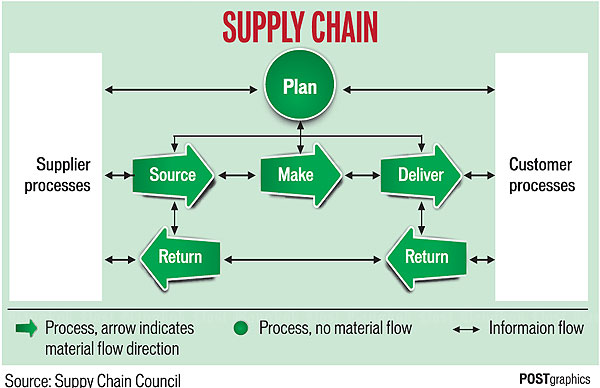We are reminded of a couple of expressions lately. First, "What goes around comes around." Second, "The more things change, the more they stay the same."

What drives this thinking is that an old "friend" has come back to visit, namely the Supply Chain Operations Reference (SCOR) model, sort of an analytical Rosetta Stone promoted by the Supply Chain Council (SCC) as a highly flexible tool to compare, link, and provide a standardised system for supply chains across a breadth of disparate industries and project sizes.
We first wrote in this space about the SCOR Model more than 10 years ago; indeed, we are unabashedly stealing from that earlier piece now. Even then, it was a well-established reference in the supply chain management world, and the SCC has since gone from strength to strength. We are finding lately that it is finally getting an even better grip in this part of the world, especially in China. Perhaps it is time for the same in Thailand?
The SCOR model uses a simple "building block" approach and a common set of definitions so that, regardless of the complexity of the supply chain being analysed, the model can be used to describe and provide a basis for supply chain improvement.
This is a business process reference model that has been developed to describe the activities associated with all phases of satisfying customer demand. It links process elements, metrics, best practices and the features associated with the execution of a supply chain in a unique format.
The SCOR model contains seven basic sections consisting of the five primary management processes _ Plan, Source, Make, Deliver, and Return _ together with an Introduction and a Glossary. For modelling purposes, Make and Return are further subdivided. Make focuses on three environments _ Make-to-Stock, Make-to-Order, and Engineer-to-Order. Return is documented in two locations _ Source and Deliver. Return processes that connect an organisation with its supplier (i.e., the return of raw materials) are documented as Source Return activities. Processes that connect an organisation with its customer (i.e. the receipt of returned finished goods) are Deliver Return activities.
This preserves the concept that Source connects an organisation with its suppliers and Deliver connects an organisation with its customers. The Plan and Execution (Source, Make, Deliver, Return) sections are the heart of the model, while the Glossary lists of the standard process and metrics terms that are used.
Besides the five basic management processes (Plan, Source, Make, Deliver, Return), it is useful to distinguish between the three process types in the model: plan, execute, and enable.
Planning processes balance aggregated demand across a consistent planning horizon, generally occurring at regular intervals, and can contribute to supply chain response time. For example, a planning element is a process that aligns expected resources to meet expected demand requirements. Execution processes are triggered by planned or actual demand that changes the state of products. They include scheduling and sequencing, transforming materials and services, and moving products. Enable processes prepare, maintain, and manage information or relationships on which planning and execution processes rely.
The scope of input for the model is limited to three main types of activity:
Fcustomer interactions (order entry through paid invoice);
Fall physical material transactions (supplier's supplier to customer's customer, including equipment, supplies, spare parts, bulk product, and software), and
Fall market interactions (from understanding aggregate demand to fulfilling each order).
It does not attempt to describe all business processes or activities across an organisation; specifically, the model does not address sales and marketing (demand generation), product development, R&D, and some elements of post-delivery customer support. We are pleased to observe, though, that the SCC has now ventured somewhat into the areas of product design and sales & support.
The model is silent in the areas of human resources, training, and quality assurance, among others. The SCC believes these horizontal activities are implicit in the model and there are other highly qualified organisations that deal with them.
The scope of the model has changed since its introduction and is anticipated to continue to evolve based on Council members' requirements. For example, the original versions did not include the Return process but now, with its introduction, the model has been extended into post-delivery customer support, although it does not yet include all activities in that area.
The model is designed and maintained to support supply chains of various complexities and across multiple industries. The Council has focused on three process levels but does not attempt to prescribe how a particular organisation should conduct its business or tailor its systems and information flow. Every organisation that makes supply chain improvements using the SCOR model will need to extend it at least to Level 4, using organisation-specific processes, systems and practices.
As we said, SCOR is an old friend in our work, a tried and a true standard that is certainly standing the test of time as well as evolving very nicely, thanks to the Supply Chain Council. Wonderfully detailed references are easily found online.
The Link is coordinated by Barry Elliott and Chris Catto-Smith CMC of the Institute of Management Consultants Thailand. It is intended to be an interactive forum for industry professionals; we welcome all input, questions, feedback and news at: Barry.Elliott@inslo.com
cattoc@cmcthailand.org